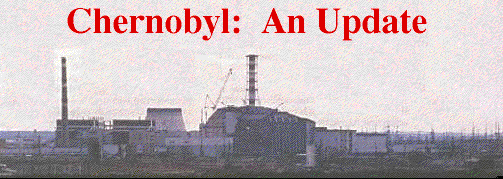Chernobyl: An Update

During the early hours of April 26, 1986 in a rural area north of Kiev,
Ukraine, who would have guessed that the careless actions of a few people
would influence the thoughts of people everywhere and change the
policies of nations. It is difficult to look at what happened at the
Chernobyl Nuclear Power Station-4 and find anything positive. However,
for the last ten years since the accident, the circumstances and
consequences surrounding this event have been used frequently to
promote zealot anti-technology causes. The goal of these WWW pages is
to present the facts and answer questions about the Chernobyl-4 accident.
The information presented here is not intended to bias opinion about
current nuclear power policy or technology in general. However, the
authors of this treatise are unequivocally pro-nuclear power and pro-technology.
We are students from the
Department of Nuclear Engineering at the
Pennsylvania State University. We believe
the facts speak for themselves. If you would like to comment on the
presentation contained in these WWW pages or if you would just like to speak
your mind, feel free to contact us at
Robert_Martin@nfuel.com
"Chernobyl: An Update" has been organized as follows:
Event Timeline
This link presents both a cursory and detailed view of the events
immediately before and following the Chernobyl accident. Much of this
information came from a Ph.D. dissertation written by Alexander Sich at
MIT.
Global Radiation Patterns
Following the accident, the Soviet Union remained hush about what had
happened; however, the secret was out in the form of radioactive effluents
which were eventual carried all around the world. First indication of
trouble was detected by Finnish atmospheric scientist working outside
Helsinki.
WHO Report on Health Effects from Chernobyl
The World Health Organization (WHO) released a report accounting its
assessment of the health effects following the Chernobyl accident. Here
is a synopsis.
RBMK vs. LWR
Major design flaws of the RBMK nuclear power plant heighten the magnitude the
disaster. Within the close society of the Soviet Union, products of technology
did not face the same scrutiny as their counterpart in the United States
and Europe; thus, allowing risky ventures to reach fruition. The Light
Water Reactors (LWR) built for commercial power in much of the world
outside the Soviet Union contain passive and active feature that would
have prevent the Chernobyl accident.
US Commercial Power Reactor Safety Research
The Chernobyl disaster renewed the debate over the safety of nuclear
power plants far beyond the Soviet Union. Following the accident (as
well as the accident at Three Mile Island near Harrisburg, PA), nations with
a great investment in nuclear power increased efforts supporting safety
research.
Chernobyl in Perspective
What happened at Chernobyl will no doubt be remember as one of the
worlds worst man-made disasters; however, does this mean humankind
should scrap every technology that "burns" us? Historically, technology
has served to solve many of the quality of life problems we all
experience daily. Sometimes this same technology has created more
problems. The solution we propose is to allow technology to solve its
own problems with more technology. Here is an article by Anatolij
Nosovksy, Deputy Director of the Chernobyl NPP.
Chernobyl:
Lies and Journalist
is a commentary written by Australian Gerry Jackson for his E-Zines
Media Alert and Viewpoint. His expose' presents some interesting facts the
media neglected to tell the public and how they have twisted other facts to
sell more newspapers.
References
References for the facts presented in "Chernobyl: An Update" have
been compile for your quick reference. Included are links to other
sites on the Web with Chernobyl related information.

Find out more about the Nuclear Engineering at Penn State and American Nuclear Society. Here are some links.
Department of Nuclear Engineering
The ANSWER: the American
Nuclear Society Worldwide Electronic Resource
Meet the authors

